Medals of 1900 Paris Universal International Exposition (original) (raw)
There’s 3 grades for this award medal: Bronze, silver and gold (gold on bronze).
About the design of the award medals:
Obverse: Depicts the head of “France” in a Phrygian bonnet near a growing oak tree which has put a laurel wreath around her head. A view of the Paris skyline to the right.
Reverse: The winged figure of Victory, holding a laurel wreath and a palm branch and carrying a winner on her back.
The Expo buildings are shown below, with a plaque which says who was the recipient of the medal. Legend: Exposition Universelle Internationale – 1900 – J. C. Chaplain
The 1900 World Fair took place in conjunction with the Olympic Games.
1900 Paris Exposition Medals
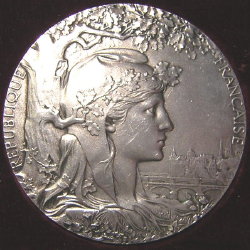
**SILVER MEDAL – 1900 UNIVERSAL EXPOSITION Paris, France
Diameter: 63mm (approx.2.5″) Weight: 100g (approx.3.5oz)Original SILVER medal, by J-C.Chaplain, a specimen in excellent condition as scanned, edge marked “ARGENT” with horn of plenty (Paris mint). Obv. Head of Marianne right. In legend : RÉPUBLIQUE FRANCAISE
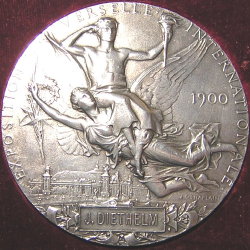
**SILVER MEDAL – 1900 UNIVERSAL EXPOSITION Paris, France
Rev. Victory flies over the exhibition, supporting a prize-winner with torch aloft
In legend : EXPOSITION UNIVERSELLE INTERNATIONALE – 1900
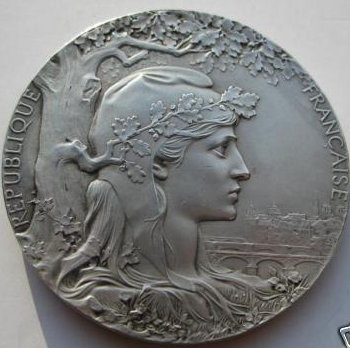
SILVERED BRONZE MEDAL- 1900 UNIVERSAL EXPOSITION Paris, France
Same design front and back as above medal but silvered over bronze composition rather than solid silver.
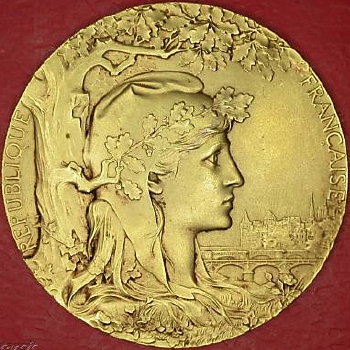
GOLD MEDAL- 1900 UNIVERSAL EXPOSITION Paris, France
Same design front and back as above medals but gold plated over bronze composition. This is a gold plated bronze medal for the 1900 Paris Exposition Universelle and Olympic games. Metal : gold on bronze / Size: 64 mm / Weight: 102 g, Hallmarked on the edge: BRONZE cornucopia
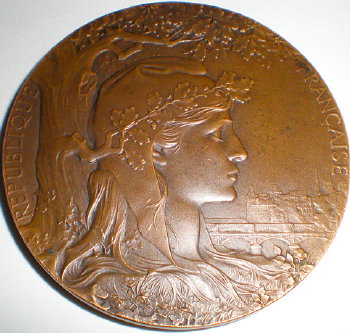
BRONZE MEDAL- 1900 UNIVERSAL EXPOSITION Paris, France
Same design front and back as above medals but bronze.
Edge: Marked with the cornucopia symbol (a symbol of food and abundance also known as the Horn of Plenty) and the word “Bronze”.
J.C. Chaplain was a master of the art nouveau style of the times.
Jules-Clément Chaplain (1839-1909) – one of the most renown French medalist of the late 19th century, his career can be described as emblemic of the “Golden Age” of Medallic Art.
He first studied sculpting and engraving at the Ecole des Beaux-Arts in Paris under such masters as Jouffroy and Oudiné. In 1863 he won the Grand Prix de Rome, allowing him to study as a resident of Villa Medici in Rome from 1864-1868.
Chaplain returned to Paris in 1869 where he found official success almost immediately, winning notice in the Salons of 1870 and 1872. In rapid succession, Chaplain was named in 1877 the official medalist of the French Government, in 1878 a Chevalier of the Legion d’Honneur, and in 1881 to the seat at the Académie des Beaux Arts left vacant by the death of Jacques-Edouard Gatteaux.
He was responsible for the official portraits of every president of the French Republic from Patrice Mac-Mahon in 1877 to Émile Loubet in 1899.
Chaplain also received the commission for engraving the gold coinage of France at the urging of Claude Roger-Marx. He also engraved commemorative and official prize medals for the Paris Exposition Universelles of 1867, 1878, 1889 and 1900.
The Exposition Universelle of 1900 was a world’s fair held in Paris, France, to celebrate the achievements of the past century and to accelerate development into the next.
More than 5 million people attended the exhibition (a world record at the time), yet it still failed to turn a profit, costing the French government 2,000,000 Francs. The fair included more than 76,000 exhibitors and covered 1.12 square kilometres of Paris.
The Exposition Universelle was where motion pictures were first unveiled and where the escalator debuted.
The exhibition lasted from 14 April until 10 November 1900. A special committee, led by Gustave Eiffel, awarded a gold medal to Lavr Proskuryakov’s project for the Yenisei Bridge in Krasnoyarsk.
A number of Paris’ most noted structures were built for the Exposition including the Gare de Lyon, the Gare d’Orsay (now the Musée d’Orsay), the Pont Alexandre III, the Grand Palais, La Ruche, and the Petit Palais.
A sideshow at the Exposition was the Second Olympic Games, which were spread over five months. So unnoted were these games that many athletes died unaware that they had been Olympians. The games also marked the first participation by female athletes and, in such sports as tennis, football (soccer), polo, rowing and tug of war, teams were multinational.